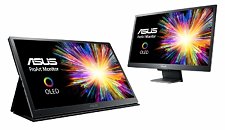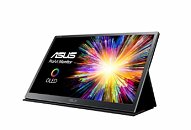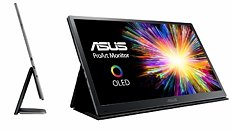Raevenlord
News Editor
- Joined
- Aug 12, 2016
- Messages
- 3,755 (1.18/day)
- Location
- Portugal
| System Name | The Ryzening |
|---|---|
| Processor | AMD Ryzen 9 5900X |
| Motherboard | MSI X570 MAG TOMAHAWK |
| Cooling | Lian Li Galahad 360mm AIO |
| Memory | 32 GB G.Skill Trident Z F4-3733 (4x 8 GB) |
| Video Card(s) | Gigabyte RTX 3070 Ti |
| Storage | Boot: Transcend MTE220S 2TB, Kintson A2000 1TB, Seagate Firewolf Pro 14 TB |
| Display(s) | Acer Nitro VG270UP (1440p 144 Hz IPS) |
| Case | Lian Li O11DX Dynamic White |
| Audio Device(s) | iFi Audio Zen DAC |
| Power Supply | Seasonic Focus+ 750 W |
| Mouse | Cooler Master Masterkeys Lite L |
| Keyboard | Cooler Master Masterkeys Lite L |
| Software | Windows 10 x64 |
If you were waiting for another OLED solution in the PC monitor space to enter the market, the ASUS ProArt PQ22UC may be answering part of your prayers. However, it likely doesn't fit your bill at all when it comes to affordability or choice of features for a gaming-centered solution. The ProArt PQ22UC features an OLED panel with 4K resolution, support for HDR, and a 10-bit panel for increased color reproduction. Aiding in color reproduction and accuracy for its professional aspirations is the fact that this monitor already comes factory-calibrated for a Delta E < 2 color accuracy rating.
The ASUS ProArt PQ22UC has an announced 1000000:1 contrast ratio (remember the pure blacks of OLED), 14-bit internal lookup table, and support for Gamma values of 2.6, 2.4, 2.2, 2.0, and 1.8. There's Micro HDMI and dual USB-CTM ports which support AC power input, data transfer speeds of up to 5 Gbps and 4K UHD output. Pricing? You'd rather not know it: it's going for €5.160,90 (Austrian retailer) or £4,699.00 in the UK.



View at TechPowerUp Main Site
The ASUS ProArt PQ22UC has an announced 1000000:1 contrast ratio (remember the pure blacks of OLED), 14-bit internal lookup table, and support for Gamma values of 2.6, 2.4, 2.2, 2.0, and 1.8. There's Micro HDMI and dual USB-CTM ports which support AC power input, data transfer speeds of up to 5 Gbps and 4K UHD output. Pricing? You'd rather not know it: it's going for €5.160,90 (Austrian retailer) or £4,699.00 in the UK.



View at TechPowerUp Main Site







